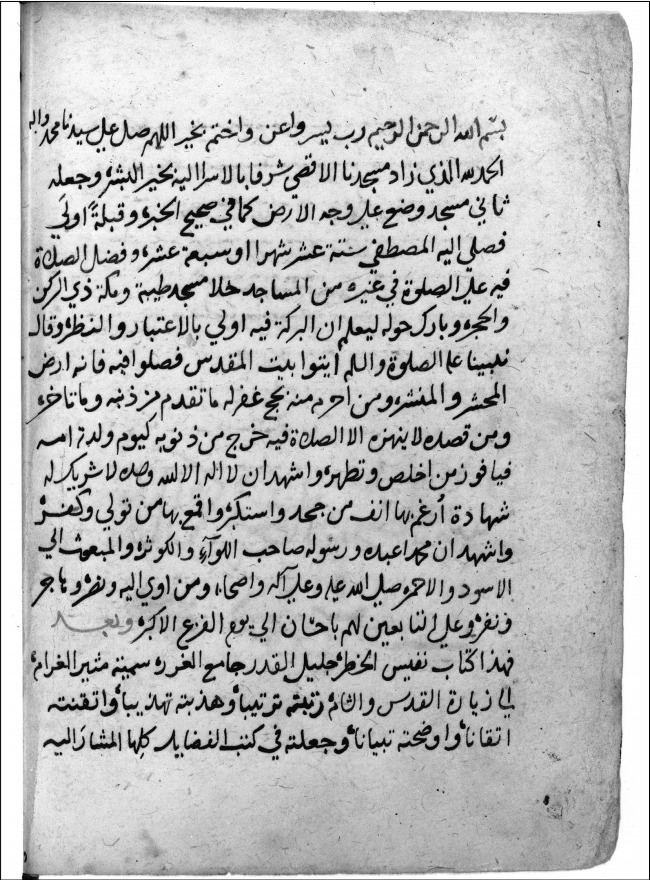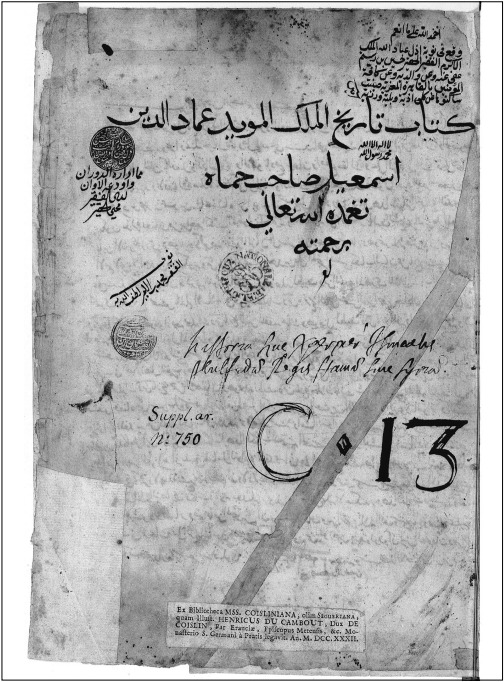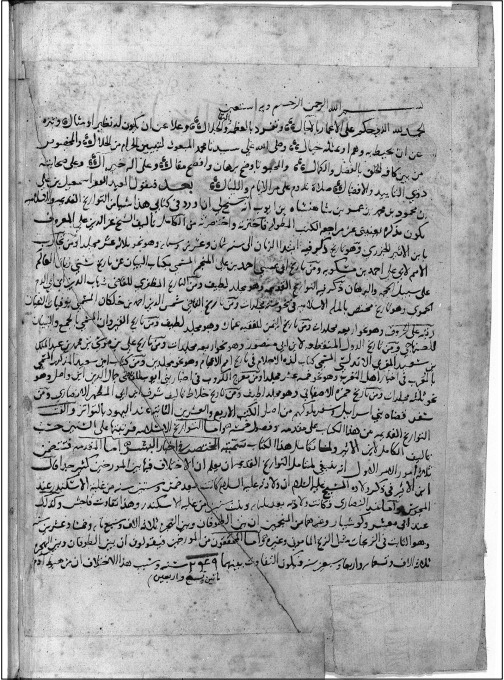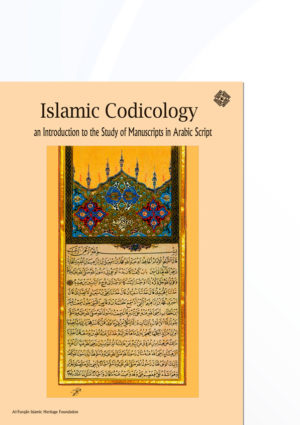François Déroche, with contributions by Annie Berthier, Marie-Geneviève Guesdon, Bernard Guineau, Francis Richard, Annie Vernay-Nouri, Jean Vezin, Muhammad Isa Waley
| Article contents: Title page Colophons and dates Location and types of colophons* Dating* The Hijra era* Month (shahr; Persian mah, Turkish ay)* Sources concerning the history of a manuscript...* |
Throughout this handbook, readers have been presented with various methods for assessing the age of a manuscript: analysis of the writing surface, the script employed, the way quires are collated, and so on. Sometimes these techniques provide the only clues - apart from any possible linguistic evidence - as to the date at which the copy under scrutiny was written. But a manuscript may also contain more precise clues to dating, such as a colophon, statement of patronage, or other mark of ownership.
Title page
In manuscripts written in Arabic script, the title of the work, sometimes accompanied by the name of the author and various notes that can guide the scholar in reconstructing their history, often appears on the recto of the first folio[1] (see illus. 113a, 113b, 114a and 114b). Because this leaf is in a particularly vulnerable position, in many manuscripts it is no longer extant (or may have been replaced at a later date). Thus whenever a manuscript with a title page is being examined, special care must be taken to study the condition of this leaf, bearing in mind that the information found there, beginning with the title of the work, may be erroneous or falsified.




Title[2]
In the early days, title pages were sober: many manuscripts present just the title inscribed in large, carefully traced letters, with no ornamentation whatsoever. MS. Vienna ÖNB Cod. A.F. 340, dated 447/ɪ055-ɪ056, provides an Oriental version of this type of presentation,[3] while the title page of a volume of al-Muda𝓌𝓌eana, given in endowment (𝓌aqf) in 424/ɪ033 by the Zīrid monarch al-Mu‘izz ibn Bādīs, shows that Western Islam followed the same rules.[4] This simple approach was long followed, in a more modest form, in copies made for ordinary use. In elaborate manuscripts, however, illumination soon began to enhance the basic information. For example, in two Vienna manuscripts (ÖNB Cod. A.F. 4. f. ɪ, dated 746/ɪ345, and A.F. 75, f. ɪ, from the eighth/fourteenth century)[5] a gilded border frames the area containing the title. Together with the title, one sometimes finds the name of the patron who commissioned the copy, according to more or less elaborate formulas; this combination plays a double role by linking the title to information that serves as an ex-libris. Such signs of ownership usually begin with traditional phrases: bi-rasm, ḥasb ishāra, bi-‘ināya, tuḥfatan li-, and so on.[6] The first folios of MSS. Vienna ÖNB Cod. N.F. 278 and A.F. 84a, dated 785/ɪ384, present two variants of the same arrangement: the title is set within an illumination, and the ex-libris of an unknown Mamlūk dignitary is written just below in gold lettering.[7] On the first folio of an almost contemporary manuscript (Vienna ÖNB Cod. N.F. 381), both pieces of information are contained in a decoration that is integrated into an overall composition; it is perhaps significant that this copy of the Burda originally belonged to the library of the Mamlūk Sultan Qalāwūn.[8] While this may appear a logical place for such information, the name of the patron who commissioned the copy, as well as the title of the work, may also be given in the colophon.[9]
Copies of the Qur’ān bear no title page, strictly speaking. Instead, a quotation from the Qur’ān or, in the case of Qur’āns in several volumes, an indication of the number of the volume, may appear on the recto of the first folio. The first leaf of MS. Paris BNF arabe 604ɪ, written at Bust in Afghanistan in 505/ɪ ɪ ɪ ɪ-ɪ ɪ ɪ2, includes both the ordinal number ‘the seventh’ and verses LVI, 77-78 of the Qur’ān.[10] At that early date, folio ɪ was still undecorated, but the following double page was followed, in some high-quality copies, by an another containing decoration with no text, the text itself beginning on the next double page. Often the text simply started on the first double page, with no preceding announcement of any sort.
The title was not always placed on the recto of f. ɪ, however. The development of illuminations framing the beginning of the text on f. ɪ v0 offered scribes and illuminators the possibility of devoting part of the decoration to a frieze containing the title of the work. Thus in a certain number of manuscripts the title appears on the verso of the first folio: MS. Vienna ÖNB N.F. 145a, written at Shiraz in 882/ɪ477-ɪ478, bears the heading ‘Muqaṭṭa‘āt Ibn Yamīn' in the frieze adorning f. ɪ vo.[11] A more developed version of this practice can be seen in a copy of ‘Aṭṭār’s Manṭiq al-ṭayr (Paris BNF persan 348, dated 897/ɪ492), where the illumination on f. ɪ vo has a pendant on the opposite page, both friezes being used to advantage to feature the title of the work and the name of the author.[12] In many books, however, the illuminated frieze on the verso of folio ɪ features a pious invocation, very often the basmala.[13]
Ex-libris and contents
As mentioned above, the name of the patron who commissioned the copy is sometimes given with the title on f. ɪ; in lavish manuscripts, it may even figure alone on that leaf (see illus. 47). Changes of ownership provided reasons for modifying this information - subsequent scraping and overwriting are usually easy to spot. One of the earliest known examples can be found in MS. Leiden BRU Or. 437, where the front page is overwritten with the name of a merchant, Muḥammad ibn Shibl, partly covering the original inscription with the name of the Ghaznawid ruler ‘Abd al-Rashīd (reigned 440-3/1049-52).[14] Conversely, illuminators sometimes decorated f. ɪ with a space in the middle apparently designed to receive the name of the patron, which was never added. Finally, mention should be made of indications of ownership that remain highly general, as when a phrase included in the decoration has been formulated in an anonymous fashion, as seen for example in MS. Vienna ÖNB Cod. A.F. 93, f. ɪ, dated 905-906/ɪ500: ‘Li-ṣāḥibih al-sa‘āda 𝓌a-l-salāma.’[15]
In this same manuscript-a copy of Niẓāmi’s Khamsa - as well as in other anthologies containing several works, the illumination includes a table of contents. Other examples include MSS. Paris BNF suppl. persan ɪ357 (f. 2),[16] dated 865/ɪ46ɪ, and Vienna ÖNB Cod. Mixt. 9ɪ4 (f. ɪ).[17] In ordinary copies, the contents were given in more basic form. Mediaeval scholars such as al-‘Almawī (tenth/sixteenth century) recommended employing this useful device and placing it at the beginning of the book.[18]
Colophons and dates
When the scribe completed the work of copying, he often took advantage of any space that remained at the end of the basic text to add information about the copy he had just completed. This text, called a colophon, was usually of limited length; and since it was not subject to strict rules, the information it contains varies from one manuscript to another.[19] The scribe might identify himself, or perhaps note the date of completion or the place where the work was done, or even for whom the copy was executed. Colophons are therefore of great importance to scholars, since reliably dated manuscripts are crucial landmarks in the field of codicological scholarship. The information contained in a colophon must therefore be analysed all the more rigorously and checked for potentially erroneous data, whether inadvertent or deliberate.
Location and types of colophons...
*The remainder of this article is exclusively available in the printed version of the related book. The book is available in both electronic and printed formats within Our Publications in the following link:
http://doi.org/10.56656/100099
[1] As in the Chapter ‘Books and their ornamentation’, the ‘first’ folio refers here to the first ‘useful’ leaf of the manuscript, even if foliation or pagination sometimes designates it by another number. As a general rule, the first useful folio will be labelled ‘fol. 1’ or ‘fol. 1v0 ’in this chapter, except when a specific manuscript is involved.
[2] The title may also appear in other places: the top edge or lower edge of the book (visible when the manuscript is stored flat, in accordance with Oriental practice), or the fore-edge flap of the binding, or even on a label glued to the upper board.
[3] Duda, Isl. Hss. 1, pp. 51-52 and illus. 1.
[4] M. al-Nayyāl, al-Maktaba al-athariyya bi-lQayra𝓌ān (Tunis, 1963), p. 18, top illus. (see also p. 14, no. 6).
[5] Duda, Isl. Hss. 2, pp. 15-17, illus. 92 and pp. 74–75, illus. 41.
[6] A. Gacek, ‘Ownership statements and seals in Arabic manuscripts’, MME 2 (1987), p. 88.
7 Duda, Isl. Hss. 2, pp. 128-129, illus. 43 and pp. 74–75, illus. 97.
8 Duda, Isl. Hss. 2, pp. 131-133 and illus. 45.
9 See below. It should also be recalled that, as mediaeval writers recommended, the title of a work was sometimes written on the edge of the text block, so that it would be visible when the book was stored flat. See F. Rosenthal, The technique and approach of Muslim scholarship (Rome, 1947), p. 11. An excellent example of this practice can be seen in GoTHA 1997, p. 73. The title might also figure on the binding, either tooled into the leather or copied onto a label glued to the top board. 10
[9] Déroche, Cat. I/2, p. 121, no. 522.
[10] Déroche, Cat I/2, p. 121, no. 522.
[11] 11 Duda, Isl. Hss. 1, p. 75 and illus. 64. For another example, see MS. Cod. A.F. 28, f. 1 v0, ibid., pp. 20-21 and illus. 344.
[12] Richard, PARIS 1997, p. 109, no. 68.
[13] Three examples appear side by side in Duda, Isl. Hss. 2, illus. 124–126.
[14] S. M. Stern, ‘A manuscript from the library of the Ghaznawid Amīr ‘Abd al-Rashīd’, in R. Pinder-Wilson (ed.), Painting from Islamic Lands (Oxford, 1969), pp. 12–13 and pl. 1; J. J. Witkam, Seυen specimens of Arabic manuscripts (Leiden, 1978), pp. 4-5.
[15] Duda, Isl. Hss. 1, pp. 33-37 and illus. 107.
[16] Richard, PARɪS1997, p. 98, no. 51 and pl. p. 92.
[17] Duda, Isl. Hss. 1, pp. 199–200 and illus. 66.
[18] Rosenthal, op. cit.
[19] Excellent introductions to the subject of colophons can be found in articles by R. Şeşen (‘Esquisse d’une histoire du développement des colophons dans les manuscrits musulmans’, Scribes, pp. 189–221) and G. Troupeau (‘Les colophons des manuscrits arabes chrétiens’, Scribes, pp. 223-231), as well as the section on dated manuscripts in Fu’ād Sayyid, Makhṭūṭ, pp. 402-415.
| Source note: This article was published in the following book: Islamic Codicology: An Introduction to the Study of Manuscripts in Arabic Script _ English version, 2005, Al-Furqan Islamic Heritage Foundation, London, UK, pp. 311-344. |


